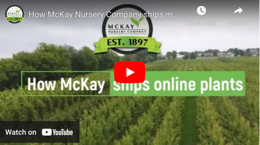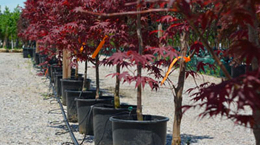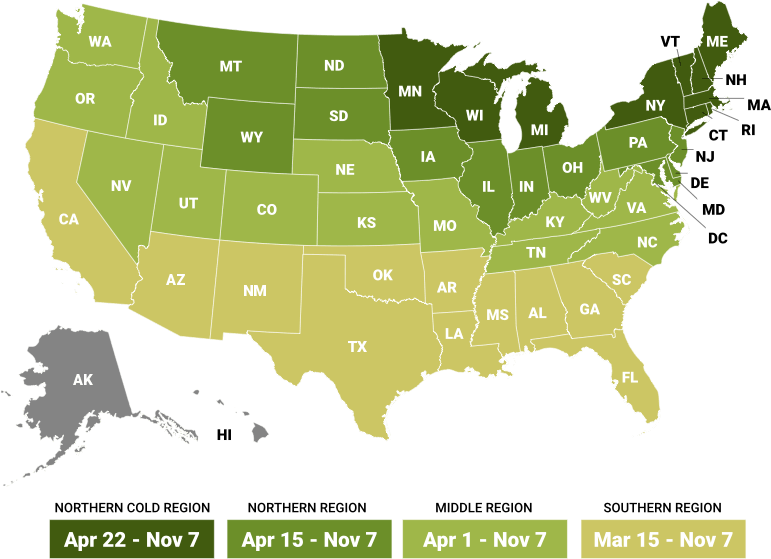
Growing zones
See Zone Map >Status: In stock
Once fall arrives, this shrub transforms into a vibrant change in color, with its bright red berries and bush honeysuckle leaves turning red in early spring. This honeysuckle plant works well for mass planting to form dense thickets, complement native vegetation, and shake up sloping areas in your landscape.
These plants are easy to work with because they’re generally low-maintenance and pest-free. They can be planted in sandy and dry soil areas and even tolerate heavy soils!
Please note: #5 containers cannot be shipped to Arizona, California, Idaho, Montana, Nevada, Oregon, Utah, Washington due to size restrictions.
- Sun, Part Sun/Shade, Shade
Mature Plant Size (H x W): 3-4' x 3-4'
Bloom Season: Summer
- Attracts Birds
- Drought Tolerant
- Native
- Rain Gardens
- Attracts Butterflies
- Attracts Pollinators
Planting & Care for Deciduous Shrub – Dwarf Bush Honeysuckle Plants
Preparation
- This honeysuckle plant works extremely well for mass planting near a woodland understory or for sloping areas in your landscape.
- Contributes to better erosion control.
- Can be planted in sandy and dry soil areas.
- Generally a low-maintenance plant that is pest-free and can tolerate heavy soils.
Mature growth is around 3-4' tall and wide. - They like full sun or partial shade.
- They prefer well-drained soils that are humus-rich, sandy loam, or clay loam.
Opening Plant Material
- Bare Root: Cut open the bundle (top and roots are tied) and separate all the plants. Soak roots in buckets of water until planted. Each plant type will be labeled separately for identification. Do not expose the roots to the sun since they should never dry out. All bare-root plants must be trimmed when planted.
- Containers: Completely saturate all container plants by putting them in a larger water container until bubbling stops. Remove the plant, then dig a hole no deeper than the depth of the container, ensuring it’s wider on the sides by an additional 6” or more.
Planting Bare Root
- Plant bare roots in fall. A good indicator of whether you can still plant is if the ground is still workable. If a hard frost is expected, hold off on planting.
- Dig a hole at least 6" wider and the same depth as the root mass. The crown or graft of the plant should be slightly higher than the ground level where it was grown at the nursery.
- Trim off the broken roots and branches.
- Place fertilizer packets in the hole (if purchased). Do not place other fertilizers in the planting hole. *Use Our Recommended Fertilizer.
- Spread the roots and fill halfway with soil, then water until the soil settles completely, saturating the soil and planting pit.
- Re-adjust the plant and fill the hole with the rest of the soil.
- Backfill the balance of the soil and water well.
Planting Containers
- Slide the plant from the pot by tapping on the bottom of the pot.
- With a shovel or knife, trim the bottom 2" off the root ball for plants in plastic containers.
- Rotate the plant to the proper position. Never lift or move plants by the tops.
Place the root ball in the hole. - Notice where the base of the trunk flares out from the tree. This is called the root flare. This root flare should show when the tree is planted. Add soil under the ball so the root flare is exposed if necessary.
- Place fertilizer packets into the bottom of the hole (if purchased). *Use Our Recommended Fertilizer.
- Backfill the hole with soil, ensuring the top of the root ball is visible and slightly higher than the soil around it.
- Firm the soil around the plant. Water well to settle soil around the root ball.
Pruning - After Planting
- Bare Root: Prune ALL bare root plants to reduce transplant shock and ensure success. Pruning should occur either before or as soon after planting as possible. All pruning should be done with a sharp pruning shears.
- Containers: Although it’s not essential for containers to be pruned after planting, light pruning can improve a Dwarf Honeysuckle’s shape. Doing so removes any broken branches from shipping or thins out a heavily branched plant to help in the transplanting process and the appearance of your new planting.
Pruning - Through-out the Season
- Keep in mind that bush honeysuckle easily rejuvenates by cutting to the ground in spring when needed.
Watering - After Planting
- Plants typically take approximately 6 weeks to establish new roots in your soil. During this period, water plants as often as every 2-4 days at the start and at least a minimum of once per week.
- Beyond the 6-week establishment period, water once per week unless rains occur.
- Remember to check soil moisture by sticking your finger into the soil around 3”.
Watering - Through-out the Season
- After the first season, plants should only be watered during extended periods without rain.
- How do you know if your plants need water? The easiest way to tell is to touch the soil around the roots. If it is moist, there is no need to water. If it’s dry, give it a good soak with the hose end (no nozzle), watering the soil only, not the leaves.
- Same as after planting, stick your finger into the soil around 3” to check soil moisture.
Frequently Asked Questions
Are there different types of bush honeysuckle?
Yes, there’s a diverse range of honeysuckle shrubs, each celebrated for their unique characteristics.
Popular variants can be from native honeysuckles from the west to Asian bush honeysuckles from the east. (e.g., Japanese honeysuckle, Tartarian honeysuckle, amur honeysuckle, northern bush honeysuckle)
Among the various types, the Dwarf Bush Honeysuckle is particularly popular, especially for those with limited gardening space. These varieties are renowned for their compact growth patterns, making them an excellent choice for smaller gardens, patios, or border plants.
What are the benefits of planting Dwarf Bush Honeysuckle in my garden?
Plantain Dwarf Honeysuckles attract pollinators, such as butterflies and bees, contributing to the health of your garden ecosystem.
When planted en masse, Dwarf Honeysuckle can help stabilize soil, preventing erosion effectively. This makes it an excellent choice for slopes or areas prone to soil degradation.
Keep in mind that the bush honeysuckle is an invasive plant species and can strangle native plants when planted incorrectly.
What do invasive Bush Honeysuckles do?
Some species of Bush Honeysuckle, especially those that are not native to North America, can become invasive shrubs in various ecosystems. These invasive varieties tend to grow aggressively, outcompeting local flora and altering habitat structures, which can lead to ecological imbalances.
To prevent these issues, it's crucial to select species that are native or non-invasive to your specific region. Consulting with local gardening experts, extension services, or ecological resources can guide you in choosing the right varieties of bush honeysuckle that will thrive in your garden without disrupting local biodiversity.
How can I propagate Dwarf Honeysuckle?
Bush honeysuckle can be propagated through several methods, including softwood cuttings, layering, and division. Taking cuttings in spring or early summer and rooting them in a moist soil mix is a common and effective way to propagate these plants.
Can bush honeysuckle be grown in pots?
Absolutely! Dwarf varieties of Bush Honeysuckle, like the Dwarf Bush Honeysuckle and dwarf honeysuckle, are particularly well-suited for container gardening. This allows those with limited space, such as balconies or small patios, to enjoy their beauty and fragrance.
Make sure to use a well-draining pot and soil mix and provide adequate water to keep them healthy and thriving.
Enhance Your Garden's Elegance With McKay Nursery
Join the century-long tradition of gardening excellence at McKay Nursery. Located in Waterloo, Wisconsin, we specialize in hardy, beautiful plant varieties, including the delightful Dwarf Bush Honeysuckle.
Order your own Dwarf Bush Honeysuckle today! Every plant from our nursery comes with the ability to purchase a one-year warranty and our superior packaging promises that your plants will arrive ready to thrive.
For personalized advice or additional support, contact us at [email protected] or call 920-478-2121.
Planting & Handling Help
Download our Planting and Handling Guide below to plan for a successful arrival and install of your plants. Be sure to water all plants as soon as they arrive and every day until you’re ready to plant. Keep any bare root bundles in a shady, cool spot with the roots covered at all times.


Learn More
Watch our videos on handling bare root plants, how your order is prepared for shipment and more.


Plant Sizing
What is the difference between Containers, Grow Bags, Bare Root, and Balled & Burlap (B&B)?
Shipping Times


Our FedEx and local shipping times depend on two factors, one is by the region and the second is the type of product being shipped. For example, small fruits are only shipped in spring, but majority of our perennials are shipped from spring until fall. Keep in mind the dates below act as a general guide. Due to unpredictable weather, staffing, inventory and industry demands these timelines can change. Therefore, we cannot guarantee any of these times.
Shipping Dates by Region*
Northern Cold Region: April 22nd - November 7th
Northern Region: April 15th - November 7th
Middle Region: April 1st - November 7th
Southern Region: March 15th - November 7th
Local Delivery (small radius from Waterloo, WI): April 22nd - November 7th
Shipping Dates by Season*
Spring Shipping: Region Start Date (above) - May
Fall Shipping: September - November
Due to unpredictable weather, these times may vary. Some varieties are exceptions due to heat and plant health reasons. Enter your shipping zip code at the top of this page and be sure to check the shipping information on each product before you add it to your cart. If the product is too large or restricted in your state, you will not be able to checkout with that item in your cart.
